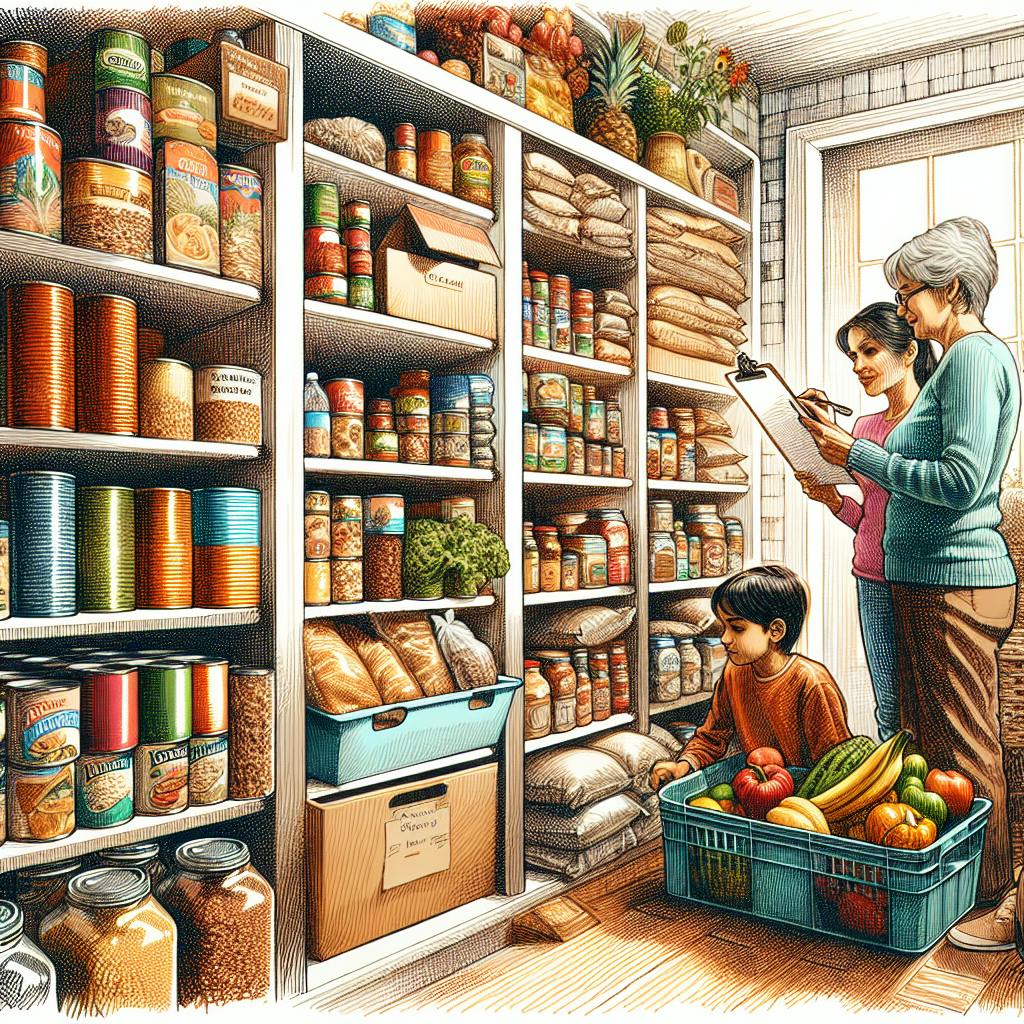Introduction to Building an Emergency Food Supply
Building an emergency food supply is a critical part of any preparedness plan. Having a well-stocked pantry provides peace of mind and ensures your family will have nourishing food to eat if a disaster strikes. When creating your stockpile, focus on nutrient-dense, long-lasting foods that your household enjoys eating. Take inventory of what you typically consume and look for non-perishable versions. Shop gradually over time, and rotate items to keep everything fresh. With some planning and organization, you can build a complete reserve to sustain you through emergencies both big and small.
When getting started, first assess your family's unique needs and eating habits. Consider potential emergency scenarios, including both short-term disruptions like power outages lasting up to 72 hours and long-term crises lasting weeks or months. Estimate the total calories each person would require per day based on age, health needs and activity level. Allow for extra food as a buffer - plan for at least 2000 calories per person daily.
Next, plan balanced emergency menus with breakfasts, lunches, dinners and snacks for each day. Focus on shelf-stable foods you already eat, like canned tuna sandwiches or oatmeal. But also stock nutritious items you may not use daily, such as beans, lentils and whole grains. Include comfort foods like coffee, chocolate and spices to lift morale in stressful times.
When shopping, stick to non-perishables that retain both nutrition and flavor for years when stored properly. Some essentials include rice, pasta, oats, canned goods, nuts, oils, dried fruit and seasonings. Look for deals online and at big-box stores like Costco and buy a little extra each trip. Grow your own fresh produce if possible and learn techniques like canning, dehydrating and curing. Rotate stock every 6-12 months.
Proper storage is key to maximizing shelf life. Use food-grade plastic buckets like the Gamma Seal Lids from Home Depot or Mylar bags along with oxygen absorbers from brands like FreshSaver. Store containers in a cool, dark place like a basement or cellar. Carefully label each container with contents and date. Once opened, transfer any leftovers to plastic or glass jars for short-term storage.
With some creativity and dedication, you can build a well-rounded emergency food reserve. Customize your stockpile to provide the calories, nutrition and comfort your family needs to stay healthy through any disaster.
Assessing Your Needs
When starting your emergency food supply, take careful stock of your household's unique circumstances. Consider the likely disasters in your region, from hurricanes to blizzards. Estimate potential duration of disruption to utilities and supply chains. Is a 72-hour bug-out bag sufficient, or should you plan for long-term, shelter-in-place scenarios lasting weeks or months?
Take an inventory of the foods you currently keep on hand and how quickly you go through them. Look at your normal weekly grocery list to identify staples to stock up on. Make notes of favorite snacks, meal components, and comfort foods frequently prepared. Consider any dietary restrictions, allergies or nutritional needs in your household.
For example, for a family of 4 with 2 adults aged 35 and 2 children aged 8 and 10, assume an average daily calorie need around 2000-2200 calories per adult, and 1600-1800 calories per child. That's a total household need of 7200-8000 calories per day as a target amount to stockpile emergency food for.
With potential emergency scenarios and food preferences in mind, calculate the total calories each person will need per day. Those with active lifestyles or doing manual labor require more energy. Allow for extra as a buffer, and to account for food waste and spoilage. Based on your household makeup and projected duration of emergency, you can arrive at the ideal quantity of food to stockpile.
Planning Your Emergency Food Menu
When building your stockpile, think through balanced, appetizing meals and snacks you can make with shelf-stable ingredients. Include familiar foods your family enjoys, as well as nutritious items you don't normally eat. Over-rely on sugary snacks, and you risk crashing energy levels. Too many salty foods may exacerbate dehydration.
Plan breakfasts, lunches, dinners and snacks that provide a mix of proteins, fruits, vegetables, grains and dairy for nutrition. For example, oatmeal, dried fruit and nuts for breakfast; tuna salad wraps and carrots for lunch; rice, beans and canned meat for dinner. Comfort foods like coffee, sweets and spices also contribute to general morale.
Make your emergency menu accommodate all members of your household. If you have kids, stock kid-friendly foods to reduce stress. Take into account any food allergies or dietary restrictions as well. Having a plan for nutritious, balanced meals utilizing your stored food will make meal prep easier in emergencies.
Here is a sample 2-day emergency menu for the 4 person family:
Day 1: Breakfast - Oatmeal with raisins, milk powder, brown sugar. Scrambled egg mix and canned fruit on the side. Lunch - Peanut butter and jelly sandwiches on whole grain bread. Trail mix and baby carrots. Dinner - Chili with canned beans, tomatoes, beef. Corn muffins.
Day 2:
Breakfast - Pancakes from mix with powdered eggs and syrup. Yogurt cups and granola.
Lunch - Rice with canned chicken, peas, broth. Dried cranberries and apricots.
Dinner - Pasta with tomato sauce and canned tuna. Green beans. Powdered milk pudding cups for dessert.
Stocking Nutritious, Long-Lasting Foods
Shop your pantry with a critical eye for longevity and nutritional content. The following foods check key boxes of lasting at least several years when stored properly, while providing calories, macros and vitamins your body needs:
-
Rice, pasta, oats for carbohydrate base. Look for whole grain versions when possible.
-
Canned or dried beans, lentils for plant-based protein.
-
Canned fruits and vegetables, chose options packed in water or juice.
-
Dried fruits like raisins, cranberries and apricots.
-
Nuts, seeds, peanut butter and nut butters for protein and fats.
-
Canned fish and meat like tuna, chicken or salmon.
-
Powdered milk, eggs and butter for dairy.
-
Cooking oil, shortening or lard for calories.
-
Sugar, honey, molasses, syrup for energy.
-
Salt, seasonings, spices, bouillon for flavor.
Look for whole-grain versions of pasta and rice for extra nutrition. Round out your stockpile with multivitamins and shelf-stable food bars like Cliff Bars for extra nutrients and calories when needed.
For optimal quality, store food 2-3 inches off the floor on shelves or pallets. Place older items in front and integrate new purchases in back. Check expiration or best-by dates and aim to use non-perishables within 6 months to a year. Be diligent about rotating your stock.
Choosing the Right Food Storage
Proper storage is essential to maximize shelf life. For dry goods like grains, beans and boxed foods, use food-grade plastic buckets like the Gamma Seal Lids from Home Depot or Mylar bags along with oxygen absorbers from brands like FreshSaver to limit oxidation and moisture. Store them in a cool, dark place like a basement or cellar.
For canned and bottled items, inspect seals and “Best By” dates carefully before use. Wipe off dusty containers, which could indicate a compromised seal. Never use canned goods that are leaking, swollen or rusted. Once opened, transfer leftovers into a plastic or glass container for short-term fridge storage.
Clearly label all containers with contents and date packaged. This allows for easy rotation and inventory management. Masking tape and a permanent marker are perfect for labeling buckets and bins. For Mylar bags, place an extra slip of paper with details inside before sealing.
By practicing proper food storage methods, you can prolong the shelf life of your stockpiled food for years to come. This provides security that your emergency reserves will be there when you need them.
Building Your Stockpile Over Time
For those with limited budgets, building a complete emergency food supply may seem daunting at first. The key is to be consistent and strategic with purchases, taking advantage of sales and buying in bulk when possible. Consider the following tips:
-
Make a master shopping list of everything you aim to stockpile. On each paycheck, buy a few extra items to gradually grow your reserves.
-
Shop at big-box stores like Costco for deals on bulk staples like rice, beans, oats and canned goods. Buying food by the case saves money.
-
When items you use regularly are on sale, stock up on extras for your emergency stash. Check sites like Slickdeals for grocery and bulk food coupon codes.
-
Grow your own vegetables in a garden to supplement your stockpile with fresh produce. Learn canning and pickling.
-
Forage for abundant wild edibles like berries and greens. Dehydrate any surplus to preserve.
-
Take inventory before shopping trips to avoid duplication. Note what’s running low in your stockpile to prioritize.
With consistent effort over months and years, you can build a well-rounded food reserve customized to your family's needs and budget.
Bug Out Bags
In addition to your main household stockpile, pack portable bug out bags with 3-5 days worth of compact, calorie-dense emergency food. Useful items include:
-
Lightweight high-calorie bars like Clif Bars.
-
Single-serve pouches of tuna, chicken or salmon. Look for pull-top cans.
-
Peanut butter and other nut butters provide protein.
-
Dried fruit like raisins, cranberries and apricots.
-
Beef jerky or other cured meats.
-
Powdered drinks like Tang, lemonade or sports mixes.
Refer to the WeLovePrepping website's Bug Out Bag Checklist for more tips on stocking grab-and-go emergency bags.
Must-Have Foods for Your Emergency Stockpile
Building an emergency food supply involves more than just gathering any non-perishables. To meet your family’s nutritional needs in a crisis, stock shelf-stable foods that provide a balance of macronutrients, vitamins and minerals. Some must-haves for your survival stockpile include:
-
Rice, pasta, oats as the carbohydrate base. Look for whole grain versions when possible.
-
Canned or dried beans and lentils for plant-based protein and fiber.
-
Canned vegetables and fruits, choosing options packed in water or juice rather than syrup.
-
Dried fruits like raisins, cranberries and apricots for vitamins.
-
Nuts, seeds, peanut butter and nut butters for protein, healthy fats and an energy boost.
-
Canned fish and meat like tuna, chicken or salmon for protein.
-
Powdered milk, eggs and butter to fulfill dairy needs.
-
Cooking oil, shortening or lard for calories and essential fatty acids.
-
Sugar, honey, molasses and syrup to provide quick energy and calories.
-
Salt, seasonings and spices for flavor and variety. Bouillon cubes add flavor to rice and vegetables.
-
Coffee, tea, powdered drinks provide comfort, hydration and a morale boost.
Don't forget water! Have at least 1 gallon stored per person per day for drinking, cooking and hygiene. Include water purification methods like filters or treatment tablets.
These foods provide balanced nutrition to keep you energized and healthy no matter the emergency. Tailor your stockpile to your family’s needs by including more of what you know you eat regularly.
Long-Lasting Staple Foods
Certain shelf-stable staples can retain quality for many years if properly stored, making them ideal long-term stockpile ingredients.
-
White rice can last 30 years or more if kept dry with oxygen absorbers. Brown rice has a shorter shelf life around 6 months.
-
Pasta maintains quality for 2+ years when kept in an airtight container. Whole grain pasta has more nutrients.
-
Dehydrated potato products like flakes, dices and granules are edible for 10-25 years.
-
Whole grains like wheat berries and oats can last up to 8 years when sealed from moisture and pests.
-
Most dried beans and legumes, including lentils, black beans and chickpeas, can be stored for 30 years if kept very dry.
-
Many nuts and seeds in the shell, such as walnuts, almonds and sunflower seeds, stay fresh for 2-4 years when stored properly.
Canned and Jarred Goods
Properly stored canned food can be your emergency stockpile’s MVP, providing fruit, veggies, meat and more. Follow these guidelines to maximize shelf life:
-
Low-acid canned goods like meat, fish and vegetables can last 2-5 years.
-
High-acid canned fruits, tomatoes and juices stay safe for 12-18 months maximum.
-
Store unopened glass jars and cans in a cool, dry place like a pantry or basement.
-
Inspect seals, dents and expiration dates carefully before opening.
-
Once opened, transfer contents to a plastic container or glass jar for fridge storage. Use within a few days.
By storing cans and jars properly and practicing first in, first out rotation, you can safely preserve foods for years.
Fats for Calories and Nutrients
In an emergency, compact sources of fat provide vital calories and nutrients. Some shelf-stable options are:
-
Vegetable and seed oils store unopened for 2-3 years. Refrigerate after opening and use within 6 months.
-
Shortening and lard can be kept 18-24 months opened, or up to 3 years if unopened in the can.
-
Canned butter and powdered varieties like butter powder and ghee powders stay fresh for several years if sealed.
-
Once opened, nut and seed butters stay usable for up to a year in the refrigerator.
-
Nuts and seeds themselves provide protein and healthy unsaturated fats. Most keep over a year.
Fats help with energy, nutrient absorption and satiety. Add oils, shortenings, nut butters and nuts to dishes for additional calories and nutrition.
Essential Flavor Boosters
Beyond keeping you nourished, stored foods must also taste good to keep morale up in trying times. Boost flavor with these timeless flavor enhancers:
-
White and brown sugar keeps almost indefinitely if properly sealed to prevent moisture.
-
Crystallized honey can be reliquified by placing the jar in warm water. It remains safe to eat indefinitely.
-
Pure maple syrup, once opened, keeps for a year in the fridge. Unopened bottles last indefinitely.
-
Molasses’ high acidity allows it to stay stable for several years after opening.
-
Salt maintains quality and flavor indefinitely if kept dry. Store in a sealed container.
-
Dried herbs and spices retain flavor for 1-3 years when stored in airtight containers in a cool place.
Umami-rich condiments like soy sauce, vinegar and hot sauce also provide welcome flavor diversity. With the right blend of spices and seasonings, your shelf-stable ingredients will taste like home cooking.
Beverages for Hydration and Morale
Having potable water and hydrating drinks is often overlooked when stockpiling food. But water and beverages provide more than just hydration. The ritual of a hot cup of coffee or tea warms the soul and lifts morale. Stock up on:
-
Several gallons of water per person for at least 2 weeks, or access to a clean water source. Include water purification methods.
-
Instant coffee has an indefinite shelf life if sealed. Store coffee filters as well. Opt for vacuum sealed bricks versus ground for freshness.
-
Powdered milk provides necessary vitamins and proteins and keeps for years unopened.
-
Black, green, herbal and medicinal tea bags. Mint and ginger aid digestion. Chamomile has a calming effect.
-
Powdered sports drinks and juice mixes for an energizing beverage.
-
Coffee filters and a French press, percolator or pour over setup to brew your stored beans.
No stockpile is complete without provisions for both hydration and comfort. We all need the daily ritual of our favorite drink.
Pet Preparedness
Don't forget emergency pet food and water for at least 2 weeks. Canned and dry kibble have long shelf lives. Consider food puzzles to slow fast eaters. Calming treats ease pet stress. Pack copies of medical records too. Reference the WeLovePrepping articles on pet preparedness for more tips.
Key Takeaways
-
Stock familiar, nutritious foods your household already enjoys and prepares. Incorporate shelf-stable versions of ingredients you use regularly.
-
Include a variety of canned goods, whole grains, beans and lentils, dried fruit and veggies, oils and fats.
-
Shop strategically and buy a little extra each time you go to the store. Take advantage of bulk deals and sales.
-
Use oxygen absorbers, Mylar bags and food-grade plastic buckets to store your stockpile. Keep containers labeled and organized.
-
Growing your own vegetables and preserving techniques like canning, dehydrating and curing provide added food security and savings.
-
Customize your stockpile to your family’s tastes, dietary needs, cooking facilities and budget.
-
A complete, well-planned emergency food reserve gives peace of mind that you can nourish your family in any disaster.
With some planning and consistency, you can amass a robust emergency food supply tailored to your household's unique circumstances and preferences. Follow these tips to stockpile nutritious, morale-boosting foods that will sustain you through whatever comes. Though the future is uncertain, food and drink provide comfort and familiarity even in the most challenging times. Your emergency reserves ensure that your family will be well-fed until order is restored.


